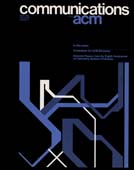April 1982 - Vol. 25 No. 4

Features
A technique for testing command and control software
A technique for testing embedded-microprocessor command and control programs is described. The continuity inherent in functions computed by programs which monitor natural phenomena is exploited by a simple difference equation-based algorithm to predict a program's next output from its preceding ones. The predicted output is compared with the actual output while indexing through the program's domain. Outputs which cannot be predicted are flagged as potential errors. Data are presented which show that this technique can be a sensitive measure of a program's correctness.
A comparison of two network-based file servers
This paper compares two working network-based file servers, the Xerox Distributed File System (XDFS) implemented at the Xerox Palo Alto Research Center, and the Cambridge File Server (CFS) implemented at the Cambridge University Computer Laboratory. Both servers support concurrent random access to files using atomic transactions, both are connected to local area networks, and both have been in service long enough to enable us to draw lessons from them for future file servers.
We compare the servers in terms of design goals, implementation issues, performance, and their relative successes and failures, and discuss what we would do differently next time.
Performing remote operations efficiently on a local computer network
A communication model is described that can serve as a basis for a highly efficient communication subsystem for local networks. The model contains a taxonomy of communication instructions that can be implemented efficiently and can be a good basis for interprocessor communication. These communication instructions, called remote references, cause an operation to be performed by a remote process and, optionally, cause a value to be returned. This paper also presents implementation considerations for a communication system based upon the model and describes an experimental communication subsystem that provides one class of remote references. These remote references take about 150 microseconds or 50 average instruction times to perform on Xerox Alto computers connected by a 2.94 megabit Ethernet.
Grapevine: an exercise in distributed computing
Grapevine is a multicomputer system on the Xerox research internet. It provides facilities for the delivery of digital messages such as computer mail; for naming people, machines, and services; for authenticating people and machines; and for locating services on the internet. This paper has two goals: to describe the system itself and to serve as a case study of a real application of distributed computing. Part I describes the set of services provided by Grapevine and how its data and function are divided among computers on the internet. Part II presents in more detail selected aspects of Grapevine that illustrate novel facilities or implementation techniques, or that provide insight into the structure of a distributed system. Part III summarizes the current state of the system and the lesson learned from it so far.
Cryptographic sealing for information secrecy and authentication
A new protection mechanism is described that provides general primitives for protection and authentication. The mechanism is based on the idea of sealing an object with a key. Sealed objects are self-authenticating, and in the absence of an appropriate set of keys, only provide information about the size of their contents. New keys can be freely created at any time, and keys can also be derived from existing keys with operators that include Key-And and Key-Or. This flexibility allows the protection mechanism to implement common protection mechanisms such as capabilities, access control lists, and information flow control. The mechanism is enforced with a synthesis of conventional cryptography, public-key cryptography, and a threshold scheme.



